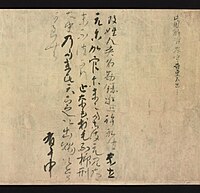
Back اللغة اليابانية القديمة المتأخرة Arabic Xaponés mediu tempranu AST قدیم ژاپون دیلی AZB Класически японски език Bulgarian Klasični japanski jezik BS Ulahing Karaang Hinapon CEB Klasická japonština Czech Klassisk japansk (sprog) Danish Klassischjapanische Sprache German Klasika japana lingvo Esperanto
| Early Middle Japanese | |
|---|---|
| 中古日本語 | |
 The oldest cursive kana written in early Heian period, indicating the birth of hiragana from Man'yōgana | |
| Region | Japan |
| Era | Evolved into Late Middle Japanese at the end of the 12th century |
Early form | |
| Hiragana, Katakana, and Han | |
| Language codes | |
| ISO 639-3 | ojp (Old Japanese) |
ojp Described as "The ancestor of modern Japanese. 7th–10th centuries AD." The more usual date for the change from Old Japanese to Middle Japanese is ca. 800 (end of the Nara era). | |
| Glottolog | None |
Early Middle Japanese (中古日本語, Chūko-Nihongo)[1] is a stage of the Japanese language between 794 and 1185, which is known as the Heian period (平安時代). The successor to Old Japanese (上代日本語), it is also known as Late Old Japanese. However, the term "Early Middle Japanese" is preferred, as it is closer to Late Middle Japanese (中世日本語, after 1185) than to Old Japanese (before 794).
- ^ Martin (1987:77)